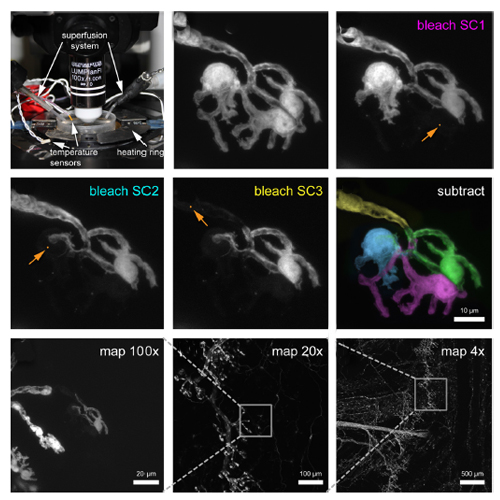Sequential Photo-bleaching to Delineate Single Schwann Cells at the Neuromuscular Junction
15-Jan-2013
Journal of Visualized Experiments, 2013, doi:10.3791/4460, 71, e4460, Page 1 of 7, published on 15.01.2013
Journal of Visualized Experiments, online article
Journal of Visualized Experiments, online article
Sequential photo-bleaching provides a non-invasive way to label individual SCs at the NMJ. The NMJ is the largest synapse of the mammalian nervous system and has served as guiding model to study synaptic structure and function. In mouse NMJs motor axon terminals form pretzel-like contact sites with muscle fibers. The motor axon and its terminal are sheathed by SCs. Over the past decades, several transgenic mice have been generated to visualize motor neurons and SCs, for example Thy1-XFP1 and Plp-GFP mice2, respectively. Along motor axons, myelinating axonal SCs are arranged in non-overlapping internodes, separated by nodes of Ranvier, to enable saltatory action potential propagation. In contrast, terminal SCs at the synapse are specialized glial cells, which monitor and promote neurotransmission, digest debris and guide regenerating axons. NMJs are tightly covered by up to half a dozen non-myelinating terminal SCs - these, however, cannot be individually resolved by light microscopy, as they are in direct membrane contact3. Several approaches exist to individually visualize terminal SCs. None of these are flawless, though. For instance, dye filling, where single cells are impaled with a dye-filled microelectrode, requires destroying a labelled cell before filling a second one. This is not compatible with subsequent time-lapse recordings3. Multi-spectral "Brainbow" labeling of SCs has been achieved by using combinatorial expression of fluorescent proteins4. However, this technique requires combining several transgenes and is limited by the expression pattern of the promoters used. In the future, expression of "photo-switchable" proteins in SCs might be yet another alternative5. Here we present sequential photo-bleaching, where single cells are bleached, and their image obtained by subtraction. We believe that this approach - due to its ease and versatility - represents a lasting addition to the neuroscientist's technology palette, especially as it can be used in vivo and transferred to others cell types, anatomical sites or species6.In the following protocol, we detail the application of sequential bleaching and subsequent confocal time-lapse microscopy to terminal SCs in triangularis sterni muscle explants. This thin, superficial and easily dissected nerve-muscle preparation7,8 has proven useful for studies of NMJ development, physiology and pathology9. Finally, we explain how the triangularis sterni muscle is prepared after fixation to perform correlated high-resolution confocal imaging, immunohistochemistry or ultrastructural examinations.











